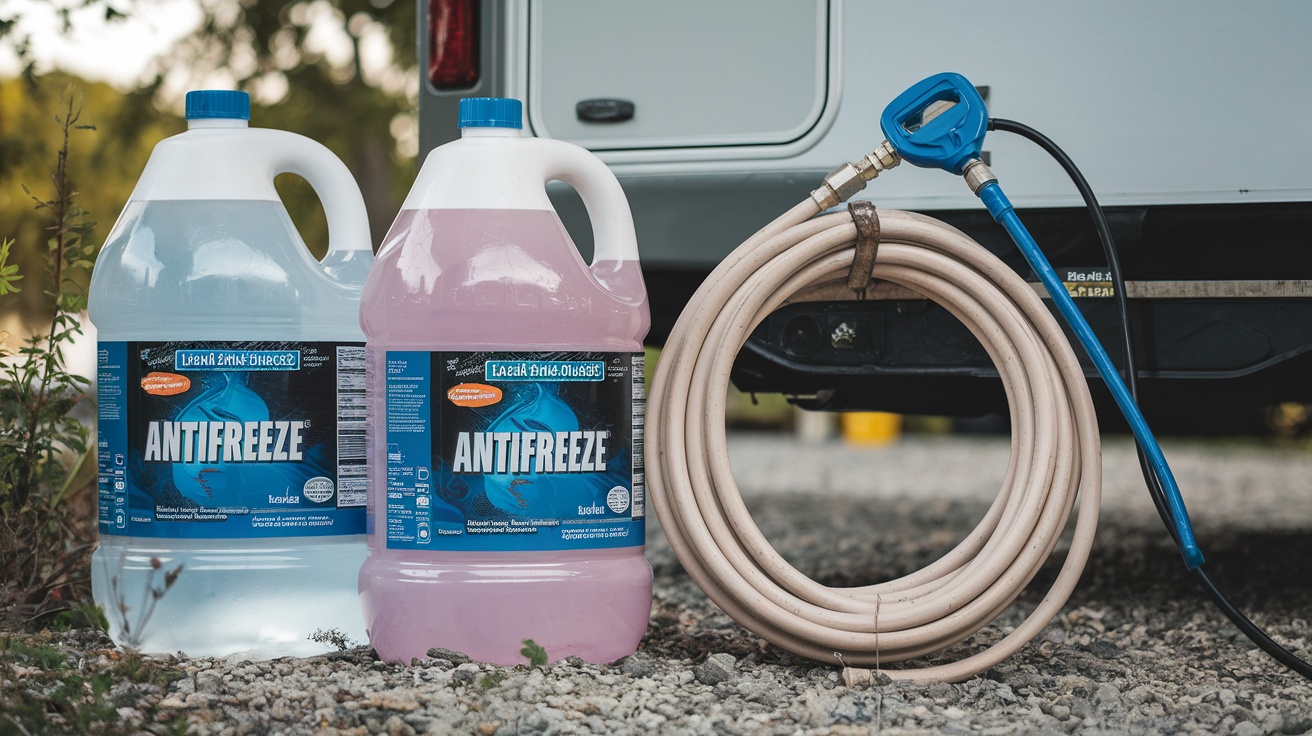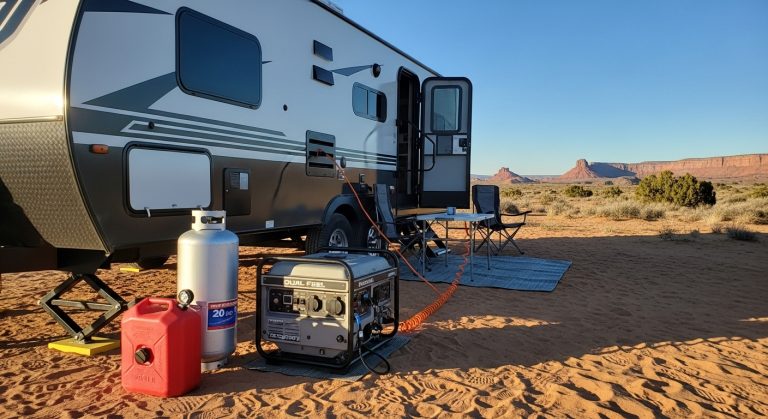When winterizing your RV, you must decide between blowing out water lines and using antifreeze. Blowing out water lines involves using an air compressor to remove moisture, preventing freeze damage without chemical residue. However, it may leave some water in low points. Conversely, antifreeze lowers the freezing point but poses environmental risks and requires careful disposal. Each method has pros and cons, so understanding them will help you make the best choice for your RV maintenance. More insights await.
Key Takeaways
- Blowing out water lines is eco-friendly and eliminates the need for toxic antifreeze chemicals.
- Antifreeze effectively lowers freezing points, but leaves chemical residues that require thorough flushing.
- Blowing out water lines can miss low points, risking freeze damage in certain areas.
- Using antifreeze necessitates proper disposal to prevent environmental contamination and harm to wildlife.
- Each method has its pros and cons; the choice depends on personal preference and system needs.
Understanding Winterization: Why It Matters
When temperatures drop, winterizing your RV becomes essential to prevent costly damage. Effective winterization protects your water pipes from freezing and bursting, safeguarding your RV systems against cold-related harm.
By taking these precautions, you also help maintain your RV’s lifespan, minimizing the risk of rot and leaks. Addressing any minor issues now can save you from escalating repair costs later. Additionally, regular inspections can help identify and mitigate moisture buildup, which can lead to mold and mildew, while storing the RV battery properly shields it from freezing. Ensuring your tires remain properly inflated preserves their condition.
Finally, winterization keeps pests at bay by sealing potential entry points, maintaining the overall integrity of your RV’s interior and exterior.
Overview of Blowing Out Water Lines
To effectively winterize your RV, blowing out the water lines is a critical step that can help prevent damage from freezing temperatures. Start by draining the hot water tank and emptying the black and grey tanks. Close the hot water tank and set the bypass valves to guarantee all tanks are empty.
You’ll need a blow-out plug, an air compressor, and a tire pump tip or water blowout adapter kit. Attach the blow-out plug to the outdoor water intake valve, set the compressor to 30-40 PSI, and turn off all faucets. Open each faucet one at a time to blow out the water. Remember to check low points in the plumbing to prevent water retention. This method is preferred for its ability to keep drinking water lines free of RV antifreeze, making it safer for consumption.
Pros of Blowing Out Water Lines
Blowing out RV water lines offers several advantages, making it a preferred method for winterization.
Here are some key benefits:
- No Antifreeze Needed: You won’t have to purchase or handle antifreeze, reducing chemical use.
- Environmental Benefits: This method is more eco-friendly, avoiding harmful disposal issues associated with antifreeze.
- Lower Annual Cost: While an air compressor may be necessary, you save money by not buying antifreeze yearly.
- Faster De-Winterizing: De-winterizing is quicker, as you won’t need to flush antifreeze from the system. Additionally, blowing out the water lines significantly reduces the risk of freeze damage by removing most moisture from the plumbing.
Cons of Blowing Out Water Lines
While blowing out RV water lines is a popular winterization method, it comes with notable downsides that can impact your RV’s plumbing system.
One major risk is incomplete water removal, as water can remain in low points or coiled lines, leading to freeze damage. Additionally, high air pressure may damage plumbing components if not managed properly. Certain areas, like P-traps and toilets, still require antifreeze for full protection.
Furthermore, some air compressors can introduce contaminants, compromising your system. In extreme temperatures, blowing out lines mightn’t provide adequate protection, increasing the risk of freeze damage, especially in hidden areas. Moreover, the effectiveness of blowing out water lines can vary significantly based on the technique used, underscoring the need for careful execution.
Finally, the process can be complex and time-consuming, requiring specialized equipment and careful attention.
Overview of Using Antifreeze
Using antifreeze for winterizing your RV plumbing system is an effective method to prevent freezing, especially in colder climates. Here are some key points to take into account:
- Types: RV antifreeze is usually ethanol or propylene glycol-based, with the latter being non-toxic and safe for plumbing.
- Freezing Protection: It replaces water, lowering the freezing point and protecting your plumbing lines. Additionally, the freezing point of most RV antifreeze is around -50℉, providing excellent protection against extreme cold.
- Usage Amounts: Most RVs need 2-4 gallons of antifreeze for winterization, including P-traps and holding tanks.
- Shelf Life: Opened antifreeze can last 1 to 4 years, depending on storage conditions.
Always dispose of antifreeze properly to avoid harming the environment and guarantee safety while handling this chemical.
Pros of Using Antifreeze
Using antifreeze for your RV’s winterization offers extensive protection for all plumbing components, including P-traps and holding tanks. The quick implementation process allows you to prepare your system efficiently, ensuring reliable performance in freezing temperatures.
This method minimizes the risk of residual water, providing peace of mind during harsh winters. Additionally, the antifreeze method is widely available at hardware and automotive stores, making it easily accessible for RV owners.
Comprehensive Protection Offered
Antifreeze provides extensive protection for your RV’s plumbing system by lowering the freezing point of water, which prevents pipes from bursting due to ice expansion.
Here are some key benefits:
- Prevents Pipe Damage: Stops ice expansion from harming pipes.
- Protects Plumbing Components: Lubricates seals in faucets and toilets, enhancing durability.
- Safeguards Against Residual Moisture: Shields against moisture that can remain even in drained pipes. Additionally, using non-toxic RV antifreeze ensures safety for humans while still providing effective protection.
- Ensures System Integrity: Protects water pumps, p-traps, and holding tanks from freezing.
Quick Implementation Process
When it comes to winterizing your RV, the antifreeze method stands out for its quick implementation process. This method is faster than blowing out water lines and requires less specialized equipment, making it ideal for beginners.
To get started, drain as much water as possible from your system, then bypass the water heater to conserve antifreeze. Connect the antifreeze to your water pump, and turn it on to circulate the antifreeze throughout the system.
You’ll see quick results as antifreeze appears at the faucets. While it may be more costly and less environmentally friendly, the ease of use and reliability make this method a convenient choice for effective winterization. Just guarantee you use RV-specific antifreeze for the best results, as 2-4 gallons is typically needed depending on your plumbing size.
Cons of Using Antifreeze
Using antifreeze in your RV comes with environmental concerns, as the chemicals involved can negatively impact nature if not disposed of properly. Additionally, lingering chemical residue may affect the taste and safety of your water system if not thoroughly flushed out.
Furthermore, it is crucial to consider that proper disposal methods are essential to minimize environmental harm when using antifreeze. These factors make it essential to weigh the drawbacks against the benefits when considering antifreeze for winterizing your RV.
Environmental Impact Concerns
Although antifreeze is commonly used to protect RV water lines, its environmental impact raises serious concerns. Here are some critical issues to contemplate:
- Toxicity to Wildlife: Antifreeze is highly toxic to pets and wildlife, leading to severe health risks or death. An estimated 10,000 animals are poisoned by antifreeze each year, highlighting the urgent need for caution.
- Groundwater Contamination: Improper disposal can contaminate groundwater, raising toxicity levels that threaten local ecosystems.
- Plant and Soil Damage: Spills can kill vegetation and alter soil pH, affecting plant growth and soil health.
- Disposal and Recycling: Many people improperly dispose of antifreeze, which is harmful and illegal. Proper disposal at recycling centers is essential to prevent environmental pollution.
Contemplating these factors, carefully evaluate your antifreeze use and disposal methods to minimize environmental harm.
Lingering Chemical Residue
While antifreeze effectively protects RV plumbing from freezing, it often leaves behind lingering chemical residue that can affect water quality. This residue can impart an unpleasant taste or odor to your water, making it unsuitable for consumption. Removing antifreeze isn’t straightforward; it requires thorough flushing of the plumbing system.
Unlike blowing out water lines, which leaves no residue, antifreeze demands careful management to guarantee all remnants are eliminated. Additionally, after flushing, sanitizing your fresh water system is essential for safety.
The presence of antifreeze in holding tanks also necessitates proper disposal to prevent contamination. Furthermore, it’s crucial to use safe antifreeze options like Propylene Glycol to minimize any adverse effects on your system.
Best Practices for Winterizing Your RV
To effectively winterize your RV, start by thoroughly draining the water supply, as this essential step prevents freezing and potential damage to the plumbing system.
Follow these best practices to guarantee a thorough winterization:
- Empty Holding Tanks: Clear freshwater, grey water, and black water tanks to avoid bacterial growth and damage.
- Remove Hookups: Disconnect all water hookups to stop any water from entering the system. This includes draining low-point drains located underneath the RV.
- Clean Appliances: Empty standing water from sinks, toilets, and ice makers to prevent freezing.
- Consult Owner’s Manual: Check your RV’s manual for specific drain locations and procedures.
Frequently Asked Questions
Can I Use Both Methods for Winterizing My RV?
Absolutely, you can use both methods for winterizing your RV.
Start by clearing the main water lines with compressed air, which removes most of the water. Then, strategically apply antifreeze in areas like sink traps where water might pool.
This combination enhances protection against freezing temperatures, but it does require more time and effort.
Just remember to follow manufacturer guidelines and verify everything’s compatible with your RV’s systems for best results.
How Long Does the Winterization Process Take?
The winterization process typically takes a couple of hours for beginners, but with experience, you can complete it in 30 to 45 minutes.
Larger RVs may require more time due to complex plumbing systems. Your choice of method also impacts the duration; simpler methods are generally quicker.
Having the right tools and supplies on hand can greatly reduce the time required, making the process smoother and more efficient.
Do I Need Special Equipment for Either Method?
Yes, you’ll need special equipment for both methods.
For blowing out RV water lines, you’ll require an air compressor, a water blowout adapter kit, and a pressure regulator.
If you choose the antifreeze method, you’ll need RV antifreeze, a water heater bypass kit, and some hand tools.
Each method has its own set of tools that guarantee effective winterization, so make sure you gather the necessary equipment before starting the process.
What Temperature Is Considered Safe for Winterizing?
For winterizing your RV, temperatures below 20°F (-7°C) for an extended period are generally considered unsafe.
When the forecast predicts temperatures dropping below 32°F (0°C) for at least 24 hours, it’s time to take action.
Daytime highs in the 40s with overnight lows in the upper 20s usually don’t require immediate winterization.
However, if you’re in a colder climate, more thorough protection is essential to prevent freezing in your plumbing system.
Can I Winterize My RV Alone, or Do I Need Help?
As you stand in your RV, tools scattered around like a mini workshop, you wonder if you can tackle winterizing alone.
Yes, you can, but be prepared for a complex process that demands time and some mechanical skill.
If you’re unsure, consider enlisting help to avoid potential damage.
It’s vital to guarantee proper drainage and antifreeze application, so weigh your comfort level against the risk of costly mistakes before diving in.
Blow Out or Antifreeze? Adventure Awaits!
When it comes to winterizing your RV, you’ve got two solid options: blowing out water lines or using antifreeze. Each method has its pros and cons, but the choice ultimately depends on your specific needs and preferences. Remember, “an ounce of prevention is worth a pound of cure.” By taking the necessary steps to protect your RV, you can avoid costly repairs and guarantee a trouble-free adventure when the warmer months return.




